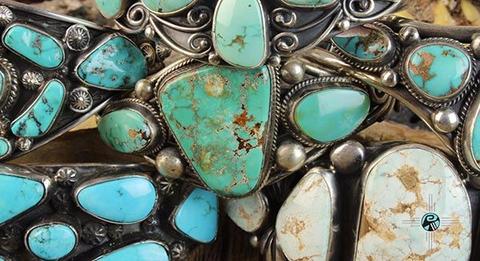Where Does Turquoise Come From?

Turquoise forms in arid regions, where rainwater filters through copper-rich soils and leaves deposits of hydrous phosphate of copper and aluminum in apertures in parent rock. As a result, major turquoise deposits generally occur in association with large copper deposits, and copper mining and turquoise harvesting often work hand-in-hand. Turquoise-producing regions have historically included northern Africa (Egypt and Iran), southern Asia (China), North America (U.S. and Mexico), and even South America (Chile).
Archeologists have found turquoise jewelry in Egyptian burial sites dates as far back as 6,000 B.C., and, by the time of the First Dynasty of Ancient Egypt (3000 B.C.), the mineral played an important role in the pharaoh culture. Egyptians extracted from the oldest-known mines, Sarabit el-Khadim and Wadi Maghareh, in the Sinai Peninsula, for thousands of years, but today, the Bedouin people only sporadically harvest turquoise there.
The Persians, of present-day Iran, called turquoise, “pirouzeh” (victory) and, later, “firouzeh.” The Nishapur mining region produced turquoise during 2,000 years, and Persia’s pure, “robin’s egg blue” color, at one time, earned the highest prices on the world market. Early Persians adorned the domes of their sacred edifications with turquoise, which, with its beautiful blue color, represented the heavens. Although Iran produces very little Persian Turquoise now, it still demands attention from global jewelry buyers. The western name for turquoise comes from the country, Turkey, which traded Iranian firouzeh with Europe.
Chinese artisans fabricated figures from soft turquoise more than 3,000 years ago. The Chinese appreciated turquoise so much that the republic only allowed the mining of choice stones by order of the emperor himself.
Today most turquoise on the market originates from the Southwestern United States, with the Sleeping Beauty Mine, of Arizona, possibly producing more material than any other mine in the world. The American culture, much newer than that of Eurasia and North Africa, found turquoise by 1,000 A.D., and archaeologists associate it with the Anasazi culture, consisting of a group that inhabited the present-day Four Corners area where the Utah, Arizona, New Mexico, and Colorado meet. More on Turquoise Mines.
Early Native Americans revered turquoise, and early jewelry from this region consisted of simple, crude designs. Native American groups from both the modern-day U.S. and Mexico regions harvested, worked, and traded turquoise and turquoise products. Some of these materials travelled widely in the Americas. For example, Archeologists, Garman Harbottle and Edward Sayre, looked at turquoise mosaics from the ancient Mayan city of Chichén Itzá in the Yucatan, of southern Mexico. They found Cerrillos mine turquoise fragments, from New Mexico, dating back to 900 AD, some 2,000 miles (3,200 km) to the northwest. Likewise, explorers have found turquoise artifacts throughout much of the southwest, into Mexico, and even into South America. Mayans, of Mesoamerica, reportedly valued turquoise more than gold!
References
Anonymous. 2015. History of Turquoise. [Online] Unknown, 2015. [Cited: January 11, 2015.] www.historyofturquoise.com/.
Danchevskaya, O. Y. 2009. Turquoise in the Life of American Indians. Proceedings of the Eighth Native Native American Symposium. [Online] Southeastern Oklahoma State University, 2009. [Cited: January 11, 2015.] http://www.se.edu/nas/files/2013/03/NAS-2009-Proceedings-Danchevskaya.pdf.
2005-2015. Turquoise: Properties of a gemstone mineral that has been held in high regard for thousands of years. Geology.com. [Online] 2005-2015. [Cited: January 11, 2015.] http://geology.com/minerals/turquoise.shtml.









